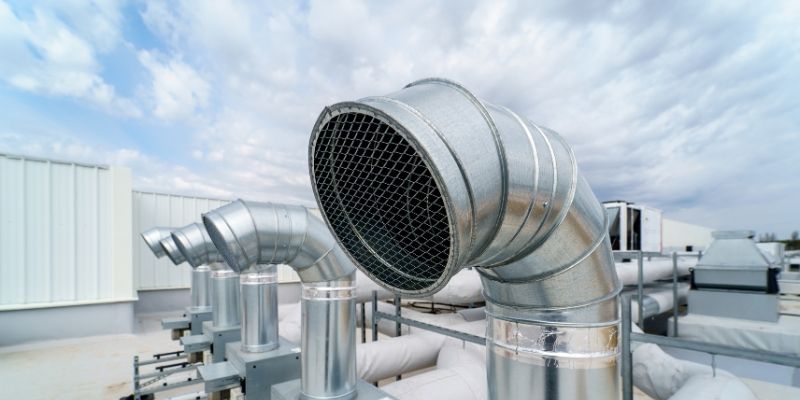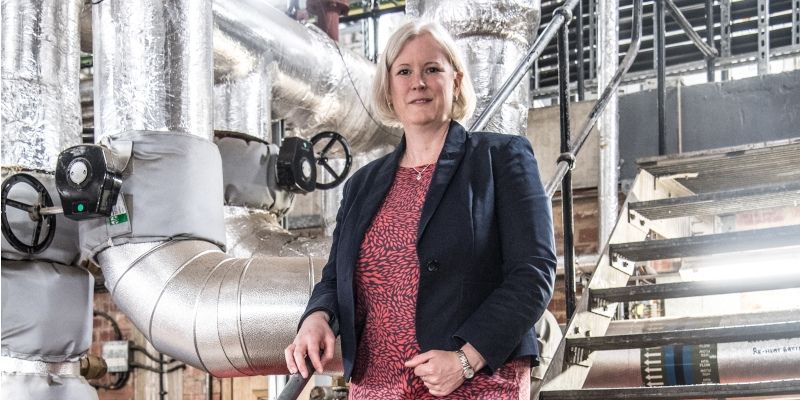
Ventilation is crucial to ensure building work aimed at improving energy efficiency doesn’t create health issues like damp and mould, according to a new report published today. (December 13)
Leeds’ Professor Cath Noakes, who contributed to the document, is among top engineers calling for policy change which puts health at the heart of plans to improve existing homes and public buildings.
The report by the National Engineering Policy Centre (NEPC) emphasises the importance of indoor air quality – to provide healthier, safer indoor environments when making energy-efficiency improvements to homes and public buildings such as schools and hospitals.
Professor Noakes, Professor of Environmental Engineering for Buildings in the School of Civil Engineering, said: “We need a more holistic approach which embeds health within the standards and design and management and operation of buildings: ensuring health outcomes are tied in, as well as energy outcomes, whether it's a new building or being retrofitted.”
She added: “It's really important that we do this now, as we deliver the essential agenda around net zero. If we don't think about health as part of the process, we condemn the next generation to poor quality environments every time we build a new public building or conduct a major retrofit. If we don't get it right, that's another 50 years before there's a change again.”
Net zero targets
The UK has set ambitious legal targets for reducing greenhouse gas emissions and achieving net zero by 2050. With the heating and cooling of buildings contributing 17% to national emissions, retrofit schemes are a critical step towards the UK achieving its net-zero goals, to mitigate the threats of climate change. As four out of five existing buildings will still be in use by 2050, making them energy efficient is a key part of any net zero plan.
The Government’s Warm Homes Plan presents an ideal opportunity to future-proof buildings and embed health outcomes in retrofit schemes, as well as improving energy efficiency, through insulation and airtightness, ventilation and air cleaning, and low-carbon heating.
The NEPC’s report, based on the knowledge and expertise of leading engineers, proposes solutions to ensure that retrofitting buildings creates healthier environments, avoiding issues with mould and indoor air pollutants. Poorly planned and executed retrofits in homes and public buildings like schools and hospitals can reduce air quality and natural light, and increase noise pollution, damp, mould and overheating.
Significant health risks
Indoor air quality has a significant impact on health and wellbeing, with disadvantaged groups facing higher risks. Damp and mould are long-running problems, with around two million people in England living in homes with these issues, which are associated with the development or exacerbation of several respiratory diseases. The importance of these issues was also highlighted in the UK Chief Medical Officer’s Annual Report 2024: Health in Cities, released yesterday. (December 12)
Retrofit schemes that take both insulation and ventilation into account should help families lower energy costs and improve indoor air quality, creating healthier, safer more sustainable living spaces. These measures will also support economic productivity and prevent illnesses connected with poor indoor environments, putting less pressure on the NHS and health resources.

Professor Cath Noakes. Credit: thisisjude.uk 2020
Professor Noakes, who specialises in airborne infections and the transport of airborne pathogens, was appointed OBE in 2020 for services to the COVID-19 response. She said: “The buildings we are talking about are not only homes, but schools, hospitals, care homes, workplaces and social spaces.
“Indoor environments have even more impact when you are considering vulnerable inhabitants, who may not have robust immune systems, like children and the elderly.
“We need to improve the standards we have around indoor air quality and then monitor and meet those standards, otherwise we risk locking in inadequate indoor air quality for future generations.”
If we don't think about health as part of the process, we condemn the next generation to poor quality environments every time we build a new public building or conduct a major retrofit.
Led by the Royal Academy of Engineering, Chartered Institution of Building Services Engineers and the Institution of Mechanical Engineers, this is the final report in a major programme of work by the NEPC on infection-resilient environments, which began in 2020 during the pandemic.
It makes five key recommendations to help embed health outcomes in building retrofit programmes:
- Health-Based Outcomes: Embed health outcomes in retrofit programmes, supported by public information campaigns.
- Public Buildings Assessment: Large-scale assessment of health risks in public buildings to inform retrofit delivery.
- Digital Passports for Buildings: Trial digital records for building performance and maintenance to support long-term management.
- Training and Skills Development: Incorporate health into training for retrofit professionals.
- Research and Development: Address knowledge gaps on long-term health impacts of indoor environments and integrate findings into policy and practice.
Holistic approach required
Retrofit schemes deliver many benefits, through the process of upgrading buildings. This includes:
- Structural change: installing insulation, upgrading windows, improving airtightness to reduce heat loss and energy demand, and provision of appropriate ventilation
- Changes to building services: such as switching to low-carbon heating
- Monitoring and control tools: installation of monitoring and control tools for energy use to empower users to adapt user-behaviour
The report outlines how to retrofit buildings with a holistic approach, to ensure that negative outcomes are avoided. Insulation and airtightness, which are essential for energy efficiency, must be balanced with ventilation to avoid moisture, mould and pollutant build-up. This will require a clear definition and targets for expected health-based outcomes, as well as cooperation between policymakers, industry, and building operators.
Professor Peter Guthrie, Chair of the Royal Academy of Engineering’s Infection Resilient Environments Working Group and Director of Research in Sustainable Development at the University of Cambridge, said: “There are many ways to improve the nation's health and improving homes is a key one. Setting out clear definitions and targets of what healthy homes and buildings look and feel like, sets out a roadmap to get us to that destination.
“Finally, training in the art and science of healthy homes, by building professionals who do this work, will be fundamental to the long-term success of retrofit schemes.”
Earlier this year, Professor Noakes was one of 40 scientists who joined forces calling for indoor air quality standards to be introduced around the globe, in an article published in prestigious journal Science.
Further Information
To read the full report, go to
Email media requests to University of Leeds press officer Deb Newman via d.newman@leeds.ac.uk and please also email the Press Office via pressoffice@leeds.ac.uk.
Picture: Adobe Stock, thisisjude.uk 2020